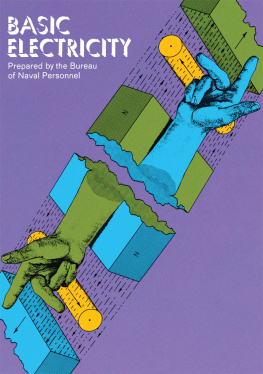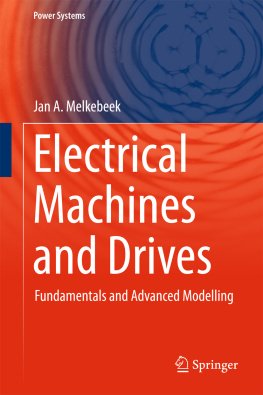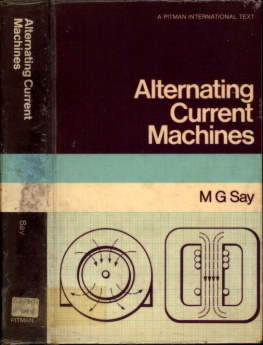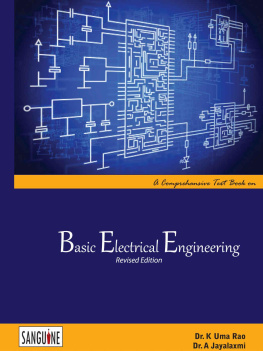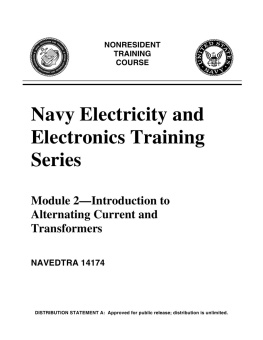BASIC ELECTRICITY
BASIC ELECTRICITY
Prepared by
THE BUREAU OF NAVAL
PERSONNEL
Second revised
and enlarged edition
Dover Publications, Inc.
New York
This Dover edition, first published in 1970, is an unabridged republication of the second revised and enlarged (1969) edition of the work originally published by the United States Government Printing Office in 1960. Basic Electricity has been prepared by the Bureau of Naval Personnel, Department of the Navy, as Rate Training Manual NAVPERS 10086-B. Active and inactive duty advancement requirements and a study guide chart are included at the end of this volume.
Library of Congress Catalog Card Number: 62-4907
International Standard Book Number
ISBN-13: 978-0-486-20973-9
ISBN-10: 0-486-20973-3
Manufactured in the United States by Courier Corporation
20973331
www.doverpublications.com
PREFACE
Basic Electricity is written for men of the U. S. Navy and Naval Reserve whose duties require them to have a knowledge of the fundamentals of electricity. A study guide chart is included to provide readily available information on chapters applicable to the various ratings.
This Rate Training Manual has been prepared by the Navy Training Publications Center, NAS Memphis, Millington, Tennessee, the Aviation Electricians Mate School, Jacksonville, Florida, the Training Publications Division of the Naval Personnel Program Support Activity, Washington, D.C., and the Naval Examining Center, Great Lakes, Illinois for technical reviews.
CONTENTS
CHAPTER 1
SAFETY
In the performance of his normal duties, the technician is exposed to many potentially dangerous conditions and situations. No training manual, no set of rules or regulations, no listing of hazards can make working conditions completely safe. However, it is possible for the technician to complete a full career without serious accident or injury. Attainment of this goal requires that he be aware of the main sources of danger, and that he remain constantly alert to those dangers. He must take the proper precautions and practice the basic rules of safety. He must be safety conscious at all times, and this safety consciousness must become second nature to him.
Much pertinent safety information is contained in Rate Training Manuals. Of particular worth is the Standard First Aid Training Course, NavPers 10081-B. In addition, directives concerning safety are published by all major commands on those specific hazards and procedures falling under the cognizance of those commands. The Chief of Naval Operations has issued a listing of specific safety precautions compiled by the Navy Department. This publication cross references safety directives by subject matter and by the identifying designation.
The purpose of this chapter is to indicate some of the major hazards encountered in the normal working conditions of the technician, and to indicate some of the basic precautions that must be observed. Although many of these hazards and precautions are general and apply to all personnel, some of them are peculiar or especially applicable to personnel concerned with electrical and electronic maintenance.
Most accidents which occur in noncombat operations can be prevented if the full cooperation of personnel is gained, and if care is exercised to eliminate unsafe acts and conditions. In the following paragraphs, some general safety rules are listed. These rules apply to personnel in all types of activities, and each individual should strictly observe the following precautions as applicable to his work or duty:
1. Report any unsafe condition or any equipment or material which he considers to be unsafe.
2. Warn others whom he believes to be endangered by known hazards or by failure to observe safety precautions.
3. Wear or use available protective clothing or equipment of the type approved for safe performance of his work or duty.
4. Report any injury or evidence of impaired health occurring in the course of work or duty.
5. Exercise, in the event of any unforseen hazardous occurrence, such reasonable caution as is appropriate to the situation.
ELECTRICAL SAFETY PRECAUTIONS
Safety precautions in this chapter are not intended to replace information given in instructions or maintenance manuals. If at any time there is doubt as to what steps and procedures to follow, consult the leading petty officer.
EFFECTS OF ELECTRIC SHOCK
The amount of current that may pass through the body without danger depends on the individual and the current quantity, type, path, and length of contact time.
Body resistance varies from 1,000 to 500,000 ohms for unbroken, dry skin. (Resistance and its unit of measurement are discussed later in this manual.) Resistance is lowered by moisture and high voltage, and is highest with dry skin and low voltage. Breaks, cuts, or burns may lower body resistance. A current of 1 milliampere can be felt and will cause a person to avoid it. (The term milliampere is discussed later in this manual; however, for this discussion it is sufficient to define milliampere as a very small amount of current or 1/1,000 of an ampere. Current as low as 5 milliamperes can be dangerous. If the palm of the hand makes contact with the conductor, a current of about 12 milliamperes will tend to cause the hand muscles to contract, freezing the body to the conductor. Such a shock may or may not cause serious damage, depending on the contact time and your physical condition, particularly the condition of your heart. A current of only 25 milliamperes has been known to be fatal; 100 milliamperes is likely to be fatal.
Due to the physiological and chemical nature of the human body, five times more direct current than alternating current is needed to freeze the same body to a conductor. Also, 60-hertz (cycles per second) alternating current is about the most dangerous frequency. This is normally used in residential, commercial, and industrial power.
The damage from shock is also proportional to the number of vital organs transversed, especially the percentage of current that reaches the heart.
Currents between 100 and 200 milliamperes are lethal. Ventricular fibrillation of the heart occurs when the current through the body approaches 100 milliamperes. Ventricular fibrillation is the uncoordinated actions of the walls of the hearts ventricles. This in turn causes the loss of the pumping action of the heart. This fibrillation will usually continue until some force is used to restore the coordinations of the hearts actions.
Severe burns and unconsciousness are also produced by currents of 200 milliamperes or higher. These currents usually do not cause death if the victim is given immediate attention. The victim will usually respond if rendered resuscitation in the form of artificial respiration. This is due to the 200 milliamperes of current clamping the heart muscles which prevents the heart from going into ventricular fibrillation.
When a person is rendered unconscious by a current passing through the body, it is impossible to tell how much current caused the unconsciousness. Artifical respiration must be applied immediately if breathing has stopped.
GENERAL SAFETY PRECAUTIONS
Because of the possibility of injury to personnel, the danger of fire, and possible damage to material, all repair and maintenance work on electrical equipment should be performed only by duly authorized personnel.
When any electrical equipment is to be overhauled or repaired, the main supply switches or cutout switches in each circuit from which power could possibly be fed should be secured in the open position and tagged. The tag should read, This circuit was ordered open for repairs and shall not be closed except by direct order of. (usually the person directly in charge of the repairs). After the work has been completed, the tag (or tags) should be removed by the same person.
Next page
